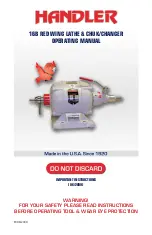
2
SAFETY INSTRUCTIONS
20. Check damaged parts.
Before further use of tool, a guard or other part that is
damaged should be carefully checked to determine that
it will operate properly and perform its intended function.
Check for alignment of moving parts, free running of
moving parts, breakage of parts, mounting and any other
conditions that may should be properly repaired or
replaced by an authorized service center unless otherwise
indicated in this instruction manual. Have defective
switches replaced by an authorized service facility. Do
not use the tool if the switch does not turn it on and off.
21. Warning.
The use of any accessory or attachment, other than those
recommended in this instruction manual or the catalog,
may present a risk of personal injury.
22. Have your tool repaired by a qualified person.
This electric tool is in accordance with the relevant safety
requirements, Repairs should only be carried out by
qualified persons using original spare parts, otherwise
this may result in considerable danger to the user.
ADDITIONAL SAFETY RULES
FOR THE LATHE
1. This lathe is designed and intended for use by proper
trained and experienced personnel only. If you are not
familiar with the proper and safe operation of a lathe,
do not use until proper training and knowledge have
been obtained.
2. Always wear eye protection while using this lathe.
3. Always use face or dust mask.
4. Do not operate this machine while tired or under
the influence of drugs, alcohol or any medication.
5. Use the right tool at the correct speed and feed rate.
6. Turning of the machine before cleaning. Use a brush or
compressed air to remove chips or debris, do not use
your hands.
7. Check the workpiece carefully for splits, knots or other
obstructions which may cause a safety risk while turning.
8. Adjust tool rest to proper height and position for the work.
Rotate the workpiece by hand to check clearance with
the tool rest before turning on the machine.
9. Select the appropriate speed for the turning job at hand.
Start at low speed and allow the lathe to ramp up to
operating speed.
10. Never apply coolants or water to a spinning workpiece.
11. Never stop a rotating workpiece with your hand.
12. If gluing up a workpiece, always use a high quality glue
of the type necessary for that particular workpiece.
13. Before attaching a workpiece to the faceplate, rough-cut
the workpiece close to the finished shape before screwing
it to faceplate.
14. When turning between centers, make sure headstock and
tailstock are snug against work piece.
ELECTRICAL REQUIREMENTS
IN THE EVENT OF A MALFUNCTION OR BREAKDOWN,
grounding provides a path of least resistance for electric
current and reduces the risk of electric shock. This tool is
equipped with an electric cord that has an equipment-grounding
conductor and a grounding plug. The plug MUST be plugged
into a matching receptacle that is properly installed and
grounded in accordance with ALL local codes and ordinances.
DO NOT MODIFY THE PLUG PROVIDED. If it will not fit
the receptacle, have the proper receptacle installed by a
qualified electrician.
IMPROPER CONNECTION of the equipment-grounding
conductor can result in risk of electric shock. The conductor
with green insulation (with or without yellow stripes) is
the equipment-grounding conductor. If repair or replacement
of the electric cord or plug is necessary, DO NOT connect
the equipment-grounding conductor to a live terminal.
CHECK with a qualified electrician or service person if you
do not completely understand the grounding instructions,
or if you are not sure the tool is properly grounded.
Refer to nether picture:
To avoid electrical hazards, fire hazards,
or damage to the tool, use proper circuit protection.
Use a separate electrical circuit for your tools. To avoid shock
or fire, if power cord is worn or cut, or damaged in any way,
have it replaced immediately.
POWER SUPPLY AND MOTOR SPECIFICATIONS
WARNING
GROUNDING INSTRUCTIONS
WARNING
This tool must be grounded while in use
to protect the operator from electrical shock.
3-prong
plug
Grounding
prong
Properly
ground
outlet
Grounding lug
Adapter
Make sure this is connected
to a known ground
Pronged
receptacle
Improper connection of equipment
grounding conductor can result in the risk of electrical
shock. equipment should be grounded while in use to protect
operator from electrical shock.
WARNING
This machine is for indoor use only.
Do not expose to rain or use in damp locations.
WARNING
- Check with a qualified electrician if you do not understand
grounding instructions or if you are in doubt as to whether
the tool is properly grounded.
- This tool is equipped with an approved cord and a 3-prong
grounding type plug for you protection against shock
hazards.
- Grounding plug should be plugged directly into a properly
installed and grounded 3-prong grounding-type
receptacle, as shown.
- Do not remove or alter grounding prong in any manner.
in the event of a malfunction or breakdown, grounding
provides a path of least resistance for electrical shock.

































